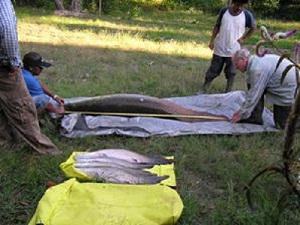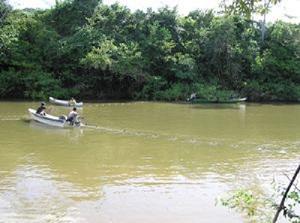Linet Watson
This project aims to document the biology and ecology of the Guyanese arapaima population and to evaluate the current conservation status. These data will allow us to develop an effective management and conservation plan that could prevent possible extirpation of the arapaima from the Essequibo basin, and at the same time support local livelihoods through sustainable fisheries.

The long-lived paternal nest guarding arapaima (Arapaima gigas) is the largest scaled freshwater fish species in South America, attaining a length of up to 3 m and weighing over 200 kg. This obligate air-breathing predator is one of the most important commercial fishes in the Amazon basin, and is now considered to be over-exploited throughout most of its native range (Brazil, Colombia, Guyana, Ecuador and Peru). Although arapaima has been commercially exploited for more than 100 years, natural history and ecological studies have only recently begun, and most of those have focused on Peruvian and central Brazilian Amazonian populations.

In Guyana, arapaima is confined to the Essequibo River and its tributaries the Rupununi and Rewa Rivers in the North Rupununi District. For local residents in that region, fishing is an important subsistence and economic activity; however, intense unmanaged exploitation of arapaima in the last 30 years has drastically reduced the stocks. Today, the livelihoods of local communities and wetland ecosystems in the North Rupununi District are threatened as the arapaima population has been reduced to an estimated 500 adult individuals measuring over 1 m.
The main constraint to developing an effective management plan for sustainable harvesting of arapaima is the lack of information on their biology and ecology. This project aims to document both missing aspects to evaluate the current conservation status of the Guyanese arapaima population. These data will allow us to develop an effective management and conservation plan that could prevent possible extirpation of the arapaima from the Essequibo basin, and at the same time support local livelihoods through sustainable fisheries. Secondary goals include designing and evaluating a model to demonstrate that arapaima fishing can be a viable income-generating alternative for local communities in Guyana. I anticipate that such a management framework can be applied to other important commercial fish species in this ecosystem.